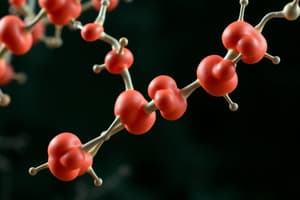Podcast
Questions and Answers
In non-ruminants, what key substance derived from glucose is primarily used for fat synthesis?
In non-ruminants, what key substance derived from glucose is primarily used for fat synthesis?
Pyruvate
Why can't acetyl CoA directly enter the cytosol from the mitochondria, and how is this issue resolved for fatty acid synthesis?
Why can't acetyl CoA directly enter the cytosol from the mitochondria, and how is this issue resolved for fatty acid synthesis?
Acetyl CoA cannot penetrate the mitochondrial membrane. It is resolved by condensing with oxaloacetate to form citrate, which can pass into the cytosol, where it is then converted back to acetyl CoA by ATP citrate lyase.
What are the two key enzymes that ruminants lack or have very low activity of, preventing them from efficiently converting glucose to fat?
What are the two key enzymes that ruminants lack or have very low activity of, preventing them from efficiently converting glucose to fat?
ATP citrate lyase and NADP malate dehydrogenase (malic enzyme)
Where does the cytosolic synthesis of palmitate from acetyl coenzyme A primarily occur in the body?
Where does the cytosolic synthesis of palmitate from acetyl coenzyme A primarily occur in the body?
What cofactors are required for the cytosolic synthesis of palmitate from acetyl coenzyme A?
What cofactors are required for the cytosolic synthesis of palmitate from acetyl coenzyme A?
What is the role of carnitine in the process of fatty acid oxidation?
What is the role of carnitine in the process of fatty acid oxidation?
What are the four key steps involved in mitochondrial fatty acid oxidation?
What are the four key steps involved in mitochondrial fatty acid oxidation?
Which process, elongation or desaturation, can introduce double bonds beyond the omega-9 carbon in fatty acids?
Which process, elongation or desaturation, can introduce double bonds beyond the omega-9 carbon in fatty acids?
What products are formed when palmitic acid undergoes beta-oxidation?
What products are formed when palmitic acid undergoes beta-oxidation?
Explain why the composition of depot fat in non-ruminants can be altered significantly by the character of dietary fat, while in ruminants it is not as easily changed.
Explain why the composition of depot fat in non-ruminants can be altered significantly by the character of dietary fat, while in ruminants it is not as easily changed.
Flashcards
Fat Synthesis in Non-Ruminants
Fat Synthesis in Non-Ruminants
In non-ruminants, glucose is the primary substance for fat synthesis.
Ruminant Energy Source
Ruminant Energy Source
Excess energy from the rumen is primarily acetate and butyrate.
Acetyl CoA Transport
Acetyl CoA Transport
Acetyl CoA condenses with oxaloacetate to form citrate, which moves to the cytosol for fatty acid synthesis.
Mitochondrial Fatty Acid Elongation
Mitochondrial Fatty Acid Elongation
Signup and view all the flashcards
Fatty Acid Desaturation
Fatty Acid Desaturation
Signup and view all the flashcards
Fat Synthesis Location
Fat Synthesis Location
Signup and view all the flashcards
β-Oxidation
β-Oxidation
Signup and view all the flashcards
Carnitine's Role
Carnitine's Role
Signup and view all the flashcards
Carnitine palmitoyltransferase (CPT)
Carnitine palmitoyltransferase (CPT)
Signup and view all the flashcards
Study Notes
Biosynthesis of Fatty Acids
- Excess calories are converted to liver and muscle glycogen, then to fat when glycogen stores are full
Non-Ruminants
- Glucose is the primary substance for fat synthesis, entering the glycolytic cycle and becoming pyruvate
- Oxaloacetate and pyruvate are diverted to acetyl CoA for fat synthesis when there is sufficient food
Acetyl CoA Transport
- Acetyl CoA cannot penetrate the mitochondrial wall, but citrate can
- Acetyl CoA condenses with oxaloacetate to form citrate, which moves to the cytosol
- In the cytosol, oxaloacetate is removed by ATP citrate lyase, making acetyl CoA available for fatty acid synthesis
- Oxaloacetate converts to malate via NADP malate dehydrogenase and then to pyruvate before returning to the citric acid cycle
Ruminants
- Excess energy from the rumen is primarily acetate and butyrate.
- Propionate is preferentially diverted to glucose.
- Ruminants cannot convert glucose to fat due to very low activity of ATP citrate lyase and NADP malate dehydrogenase (malic enzyme)
Acetyl CoA Importance
- Acetyl CoA is the starting point and chief source of pyruvate from carbohydrate metabolism in non-ruminants and acetate in ruminants
Three Systems of Fatty Acid Synthesis
- There are three systems of fatty acid synthesis
Cytosolic Synthesis of Palmitate
- The first system is cytosolic synthesis of palmitate from acetyl coenzyme A
- Active in the liver, kidney, brain, lungs, mammary gland, and adipose tissue.
- Requires NADPH, ATP, and CO2.
- Acetyl CoA and malonyl CoA react with acyl carrier protein (ACP) and condense to acetoacetyl-ACP, which is reduced to butyryl-ACP
- Butyryl-ACP reacts with malonyl-ACP, elongating the chain to 16-carbon Palmityl-ACP
- The overall reaction involves 1 mole of acetyl CoA, 7 moles of malonyl CoA, 14 NADPH, and 14 H+ to produce palmitate, 7 CO2, 14 NADP, 6 H2O, and 8 coenzyme A
Mitochondrial System
- The second system is the mitochondrial system for elongation of fatty acid chains
- It is active only under anaerobic conditions
- Fatty acid chains are elongated by two-carbon addition with malonyl CoA as the donor
- Saturated fatty acids with 18, 20, 22, and 24 carbon atoms are produced in the endoplasmic reticulum
Desaturation
- The third system is desaturation of preformed fatty acids
- Occurs in the endoplasmic reticulum of the microsomes
- Stearic acid is converted to oleic acid.
- Mammals cannot synthesize linoleic and alpha linolenic acid
- Mammals lack enzymes to introduce a double bond beyond ω9
- Double bonds are introduced into ingested fatty acid chains by fatty acyl-CoA desaturases in the microsomes
Fat Synthesis
- Direct synthesis of triacylglycerols (triglycerides) from monoacyl- glycerols occurs in the intestinal mucosa of higher animals
Synthesized Fats
- In animals, fat synthesized from carbohydrates is about two-thirds unsaturated fatty acids
- In non-ruminants, composition of depot fat is altered by dietary fat.
β-Oxidation of Fatty Acids
- Fatty acids combine with albumin and circulate as an albumin-fatty acid complex
- Fatty acid oxidation begins in the extramitochondrial cytoplasm with the formation of fatty acyl CoA (fatty acid + coenzyme A)
- Fatty acyl CoA needs carnitine to enter the mitochondrion
- Knoop proposed that fatty acids were oxidized physiologically by β-oxidation
Mitochondrial Process
- In the mitochondria, fatty acyl CoA is successively dehydrogenated, hydrated, dehydrogenated again, and cleaved to acetyl CoA and a fatty acid shorter by two carbon atoms
- The process continues stepwise, each sequence producing a molecule of acetyl CoA
- Acetyl CoA enters the TCA cycle and is oxidized to CO2 + H2O
- The acetyl CoA that is formed can be condensed to form acetoacetate and ketone bodies, converted to malonyl CoA for fatty acid synthesis, or react with acetoacetyl units in sterol synthesis
- Fatty acids with odd numbers of carbon atoms are metabolized successively by two carbon units, similar to even-carbon acids
- Propionate can form malonyl CoA and follow the lipid pathway, or Succinyl CoA and follow the carbohydrate pathway
Role of Carnitine
- Dairy ruminants are susceptible to metabolic disorders and infectious diseases during the periparturient period
- Hepatic oxidation of long-chain fatty acids occurs in mitochondria and peroxisomes
- L-Carnitine is required for mitochondrial fatty acid oxidation
- Mitochondrial fatty acid oxidation involves uptake and activation of fatty acids to fatty acyl-CoA, translocation of fatty acyl CoA into the mitochondria, and beta-oxidation.
- Carnitine palmitoyltransferase (CPT) system allows fatty acids to be translocated into the mitochondria
- Carnitine abomasal infusion (20 g/d) influenced hepatic and peripheral nutrient metabolism in dairy cows fed for ad libitum intake
- L-Carnitine abomasal infusion decreased liver lipid accumulation during feed restriction, increasing the capacity for hepatic fatty acid oxidation
Studying That Suits You
Use AI to generate personalized quizzes and flashcards to suit your learning preferences.




